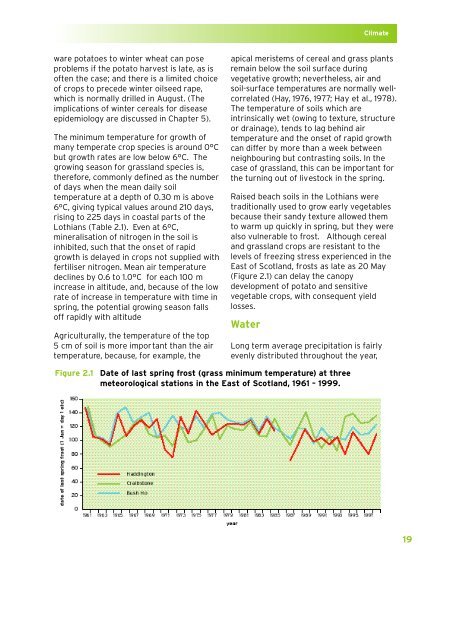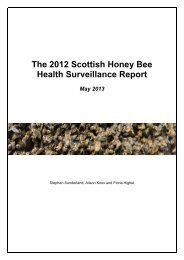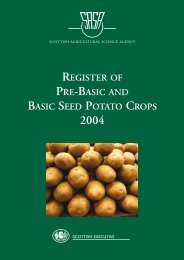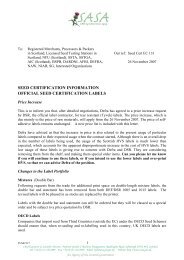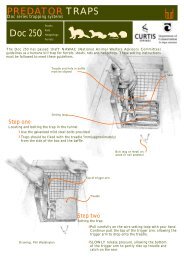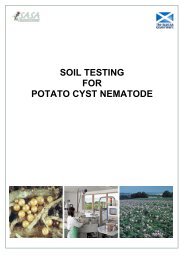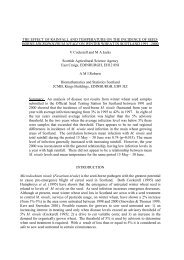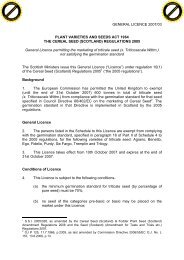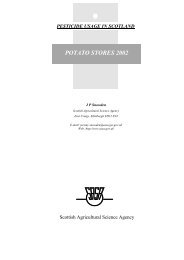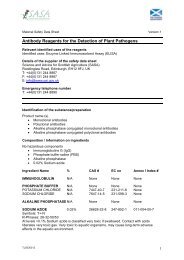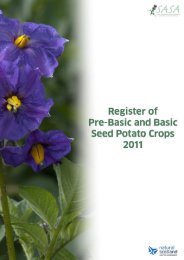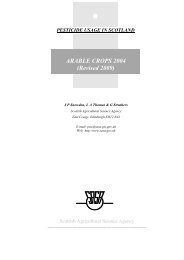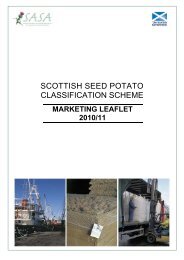Create successful ePaper yourself
Turn your PDF publications into a flip-book with our unique Google optimized e-Paper software.
Climateware potatoes to w<strong>in</strong>ter wheat can poseproblems if <strong>the</strong> potato harvest is late, as is<strong>of</strong>ten <strong>the</strong> case; and <strong>the</strong>re is a limited choice<strong>of</strong> crops to precede w<strong>in</strong>ter oilseed rape,which is normally drilled <strong>in</strong> August. (Theimplications <strong>of</strong> w<strong>in</strong>ter cereals for diseaseepidemiology are discussed <strong>in</strong> Chapter 5).The m<strong>in</strong>imum temperature for growth <strong>of</strong>many temperate crop species is around 0°Cbut growth rates are low below 6°C. Thegrow<strong>in</strong>g season for grassland species is,<strong>the</strong>refore, commonly def<strong>in</strong>ed as <strong>the</strong> number<strong>of</strong> days when <strong>the</strong> mean daily soiltemperature at a depth <strong>of</strong> 0.30 m is above6°C, giv<strong>in</strong>g typical values around 210 days,ris<strong>in</strong>g to 225 days <strong>in</strong> coastal parts <strong>of</strong> <strong>the</strong>Lothians (Table 2.1). Even at 6ºC,m<strong>in</strong>eralisation <strong>of</strong> nitrogen <strong>in</strong> <strong>the</strong> soil is<strong>in</strong>hibited, such that <strong>the</strong> onset <strong>of</strong> rapidgrowth is delayed <strong>in</strong> crops not supplied withfertiliser nitrogen. Mean air temperaturedecl<strong>in</strong>es by 0.6 to 1.0°C for each 100 m<strong>in</strong>crease <strong>in</strong> altitude, and, because <strong>of</strong> <strong>the</strong> lowrate <strong>of</strong> <strong>in</strong>crease <strong>in</strong> temperature with time <strong>in</strong>spr<strong>in</strong>g, <strong>the</strong> potential grow<strong>in</strong>g season falls<strong>of</strong>f rapidly with altitudeAgriculturally, <strong>the</strong> temperature <strong>of</strong> <strong>the</strong> top5 cm <strong>of</strong> soil is more important than <strong>the</strong> airtemperature, because, for example, <strong>the</strong>apical meristems <strong>of</strong> cereal and grass plantsrema<strong>in</strong> below <strong>the</strong> soil surface dur<strong>in</strong>gvegetative growth; never<strong>the</strong>less, air andsoil-surface temperatures are normally wellcorrelated(Hay, 1976, 1977; Hay et al., 1978).The temperature <strong>of</strong> soils which are<strong>in</strong>tr<strong>in</strong>sically wet (ow<strong>in</strong>g to texture, structureor dra<strong>in</strong>age), tends to lag beh<strong>in</strong>d airtemperature and <strong>the</strong> onset <strong>of</strong> rapid growthcan differ by more than a week betweenneighbour<strong>in</strong>g but contrast<strong>in</strong>g soils. In <strong>the</strong>case <strong>of</strong> grassland, this can be important for<strong>the</strong> turn<strong>in</strong>g out <strong>of</strong> livestock <strong>in</strong> <strong>the</strong> spr<strong>in</strong>g.Raised beach soils <strong>in</strong> <strong>the</strong> Lothians weretraditionally used to grow early vegetablesbecause <strong>the</strong>ir sandy texture allowed <strong>the</strong>mto warm up quickly <strong>in</strong> spr<strong>in</strong>g, but <strong>the</strong>y werealso vulnerable to frost. Although cerealand grassland crops are resistant to <strong>the</strong>levels <strong>of</strong> freez<strong>in</strong>g stress experienced <strong>in</strong> <strong>the</strong><strong>East</strong> <strong>of</strong> <strong>Scotland</strong>, frosts as late as 20 May(Figure 2.1) can delay <strong>the</strong> canopydevelopment <strong>of</strong> potato and sensitivevegetable crops, with consequent yieldlosses.WaterLong term average precipitation is fairlyevenly distributed throughout <strong>the</strong> year,Figure 2.1 Date <strong>of</strong> last spr<strong>in</strong>g frost (grass m<strong>in</strong>imum temperature) at threemeteorological stations <strong>in</strong> <strong>the</strong> <strong>East</strong> <strong>of</strong> <strong>Scotland</strong>, 1961 – 1999.19


